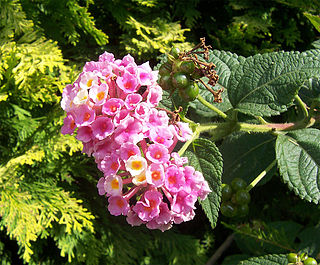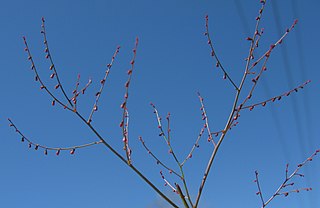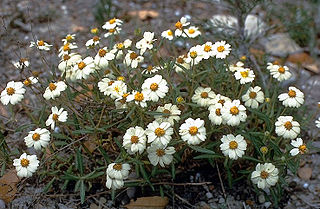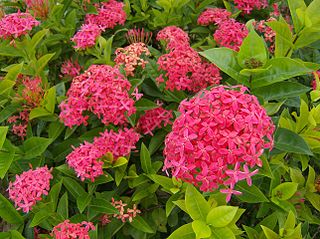
Scaevola is a genus of flowering plants in the Goodenia family, Goodeniaceae. It consists of more than 130 species, with the center of diversity being Australia and Polynesia. There are around 80 species in Australia, occurring throughout the continent, in a variety of habitats. Diversity is highest in the South West, where around 40 species are endemic.

The Verbenaceae, the verbena family or vervain family, is a family of mainly tropical flowering plants. It contains trees, shrubs, and herbs notable for heads, spikes, or clusters of small flowers, many of which have an aromatic smell.

Phyllota is a genus of flowering plants in the legume family, Fabaceae. It includes 11 species of shrubs native to temperate southeastern and southwestern Australia, in the states of New South Wales, Queensland, South Australia, Victoria, and Western Australia. They inhabit open woodland and forest, mallee woodland, and heathland, from coastal to semi-arid and montane areas.

The Heliantheae are the third-largest tribe in the sunflower family (Asteraceae). With some 190 genera and nearly 2500 recognized species, only the tribes Senecioneae and Astereae are larger. The name is derived from the genus Helianthus, which is Greek for sun flower. Most genera and species are found in North America and South America. A few genera are pantropical.

Olearia, most commonly known as daisy-bush, is a genus of flowering plants belonging to the family Asteraceae, the largest of the flowering plant families in the world. Olearia are found in Australia, New Guinea and New Zealand. The genus includes herbaceous plants, shrubs and small trees. The latter are unusual among the Asteraceae and are called tree daisies in New Zealand. All bear the familiar daisy-like composite flowerheads in white, pink, mauve or purple.

Actinotus is a genus of flowering plants in the family Apiaceae, subfamily Mackinlayoideae, with about 18 species. It is native to Australasia. Its best known member is the flannel flower, a common sight in Sydney bushland in the spring. The generic name, meaning "furnished with rays" is derived from the Greek stem aktin-/ακτιν- "ray" or "sunbeam".

Tageteae is a tribe of the plant family Asteraceae. It consists of approximately 260 species divided among 32 genera. All are found in the New World, with a center of diversity in the Mexican highlands. The type genus is Tagetes (marigolds).

Astereae is a tribe of plants in the family Asteraceae that includes annuals, biennials, perennials, subshrubs, shrubs, and trees. They are found primarily in temperate regions of the world. Plants within the tribe are present nearly worldwide divided into over 250 genera and more than 3,100 species, making it the second-largest tribe in the family behind Senecioneae.

Tephrosia is a genus of flowering plants in the family Fabaceae. It is widespread in both the Eastern and Western Hemisphere, where it is found in tropical and warm-temperate regions.

Capparis is a flowering plant genus, comprising around 250 species in the family Capparaceae which is included in the Brassicaceae in the unrevised APG II system. These plants are shrubs or lianas and are collectively known as caper shrubs or caperbushes. Capparis species occur over a wide range of habitat in the subtropical and tropical zones.

Gaertnera is a genus of flowering plants in the family Rubiaceae. There are at least 85 species distributed across the Old World tropics from Africa to Asia.

Randia, commonly known as indigoberry, is a mostly Neotropical genus of shrubs or small trees in the Rubiaceae. As of February 2022 Plants of the World Online lists a total of 112 accepted species in the genus. Several Australian species have been reassigned to the genus Atractocarpus. These include the garden plants Atractocarpus chartaceus and A. fitzalanii.

Gonocarpus (raspwort) is a genus of flowering plants in the family Haloragaceae. The species, which are native to Australia, New Zealand and Malesia, include:

Madieae is a tribe of flowering plants in the family Asteraceae. It is sometimes considered a subtribe of Heliantheae. Notable species include the tarweeds of the Western United States as well as the silverswords of Hawaii.

Millerieae is a tribe of flowering plants belonging to the Asteroideae subfamily. Of all the genera, only Galinsoga, Guizotia, and Sigesbeckia have species native to the Old World.

Pimpinella is a plant genus in the family Apiaceae; it includes the aromatic herb anise (P. anisum).

Ixoroideae is a subfamily of flowering plants in the family Rubiaceae and contains about 4000 species in 27 tribes.
















